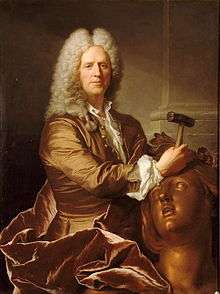Nicolas Coustou
| Nicolas Coustou | |
|---|---|
 Portrait of Nicolas Coustou at work, by Jean Le Gros (1710) | |
| Born |
9 January 1658 Lyon |
| Died |
1 May 1733 (aged 75) Paris |
| Nationality | French |
| Education | C.A. Coysevox, Académie royale de peinture et de sculpture, Académie de France à Rome |
| Known for | scultpure |
| Notable work | La Seine at la Marne, Berger Chasseur, Descent from the Cross, Julius Caesar |
| Movement | Late French Baroque |
| Awards | Prix de Rome |
Nicolas Coustou (9 January 1658 – 1 May 1733) was a French sculptor and academic.
Biography
Born in Lyon, Coustou was the son of a woodcarver, who gave him his first instruction in art. When he was eighteen years old he moved to Paris, to study under C.A. Coysevox, his maternal uncle, who presided over the recently established Académie royale de peinture et de sculpture; and at the age of twenty-three Coustou won the Colbert prize (the Prix de Rome, which entitled him to four years of education at the French Academy at Rome. He subsequently became rector and chancellor of the Academy of Painting and Sculpture. From 1700, he worked with Coysevox at the palaces of Marly and Versailles.


He was remarkable for his facility. Influenced by Michelangelo and Algardi, he tried to combine the best characteristics of each.
A number of his works were destroyed during the French Revolution; the most famous of those that remain are "La Seine at la Marne", the "Berger Chasseur", and "Daphne Pursued by Apollo" in the gardens of the Tuileries, the bas-relief "Le Passage du Rhin" in the Louvre, the statues of Julius Caesar and Louis XV in the Louvre, and the "Descent from the Cross" behind the choir altar of the cathedral of Notre Dame de Paris. His sculpture of Apollo pursuing Daphne is one of a pair bearing the single title that was created with his younger brother, who is ascribed as the sculptor of Daphne. Both have been in the Louvre since 1940 and were restored during 2004-06.
Regularly, he worked closely with his brother, Guillaume Coustou, also a renowned sculptor and director of the academy. Because of their collaborations, it is not always possible to ascribe a particular work to one or the other, thus one may find a single sculpture ascribed to each of them. His brother's son, Guillaume Coustou the Younger, also was a sculptor.
Nicolas Coustou died in Paris in 1733 at the age of 75.
References
 This article incorporates text from a publication now in the public domain: Chisholm, Hugh, ed. (1911). "article name needed". Encyclopædia Britannica (11th ed.). Cambridge University Press.
This article incorporates text from a publication now in the public domain: Chisholm, Hugh, ed. (1911). "article name needed". Encyclopædia Britannica (11th ed.). Cambridge University Press.
External links
- Catholic Encyclopedia— Nicholas Coustou
 Media related to Nicolas Coustou at Wikimedia Commons
Media related to Nicolas Coustou at Wikimedia Commons- Nicolas Coustou in American public collections, on the French Sculpture Census website
